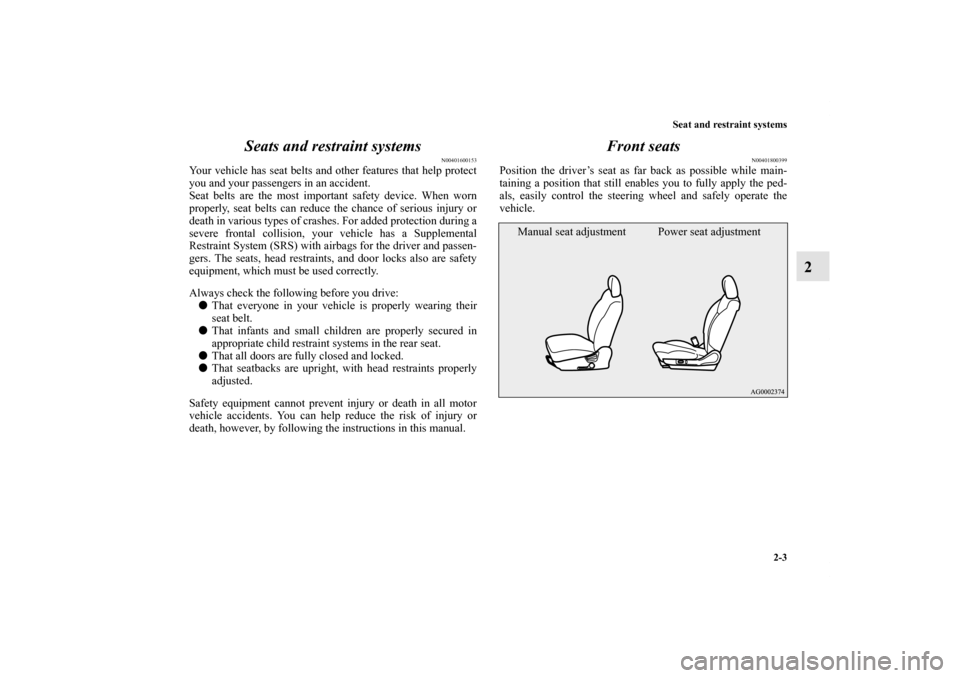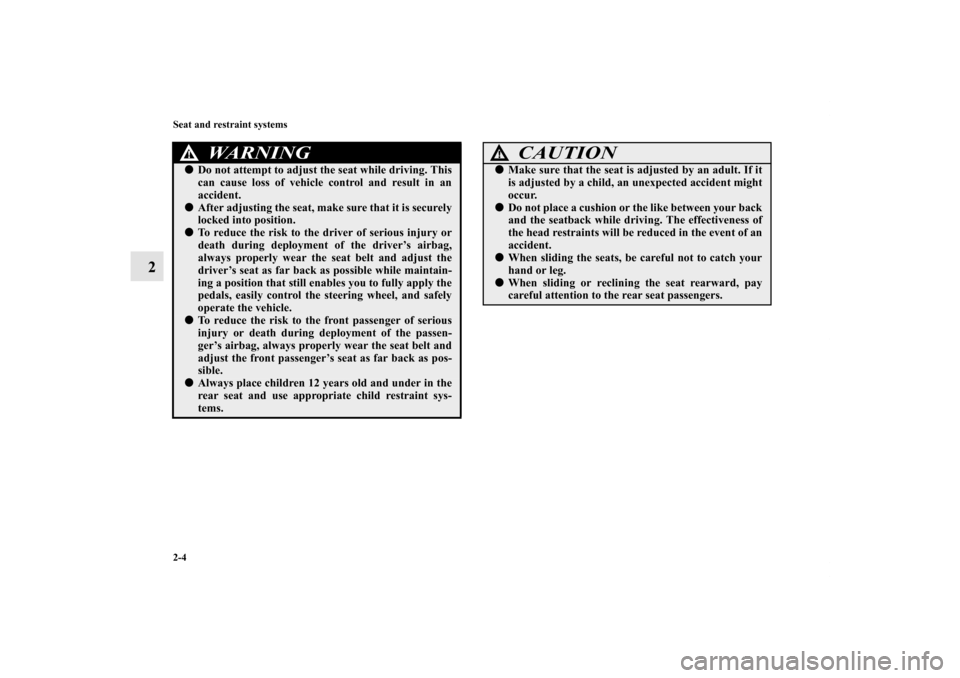Page 6 of 610
Overview
Power window switch P.3-54 Lock switch
P. 3 - 5 6 Electric remote-controlled outside mirror switch
P. 3 - 6 6
Power door lock
switch P.3-41
Adjustable seat belt shoulder anchor P.2-27 Supplemental restraint system (SRS) - curtain airbags
P. 2 - 6 0
Seat belts P.2-18
Head restraints P.2-12Inside rearview mirror
P.3-62, 3-126
Front seat P.2-2
Heated seat (if so equipped) P.2-9
Cargo room light
P. 3 - 2 4 8Supplemental restraint system (SRS) -
side airbag (for front seats) P.2-59 Tether anchors for
child restraint system
P. 2 - 3 5Sunshade illumination lamp
dimming control switch
(if so equipped) P.3-248
BK0140300US.book 4 ページ 2011年6月28日 火曜日 午後5時18分
Page 28 of 610
2
Seat and restraint systems
Seats . . . . . . . . . . . . . . . . . . . . . . . . . . . . . . . . . . . .2- 2
Seats and restraint systems. . . . . . . . . . . . . . . . . . .2- 3
Front seats . . . . . . . . . . . . . . . . . . . . . . . . . . . . . . .2- 3
Rear seats . . . . . . . . . . . . . . . . . . . . . . . . . . . . . . . .2- 11
Head restraints . . . . . . . . . . . . . . . . . . . . . . . . . . . .2- 12
Extending a luggage compartment. . . . . . . . . . . . .2- 15
Seat belts . . . . . . . . . . . . . . . . . . . . . . . . . . . . . . . .2- 18
Seat belt use during pregnancy . . . . . . . . . . . . . . .2- 29
Seat belt pre-tensioner and
force limiter systems. . . . . . . . . . . . . . . . . . . . . .2- 29
Child restraint systems . . . . . . . . . . . . . . . . . . . . . .2- 31
Maintenance and inspection of seat belts. . . . . . . .2- 42
Supplemental Restraint System (SRS) - airbag . . .2- 43
BK0140300US.book 1 ページ 2011年6月28日 火曜日 午後5時18分
Page 29 of 610
2-2 Seat and restraint systems
2Seats
N00408400482
1 - Front seat�To adjust the seat forward or backward→Page 2-5
�To adjust the seatbacks →Page 2-6
�To adjust the seat height (Driver’s seat only) →Page 2-7
�Arm rest (if so equipped) →Page 2-9
�Heated seat (if so equipped) →Page 2-9
2 - Rear seats�Arm rest (if so equipped)→Page 2-11
�Rear Seat Pass Through (if so equipped) →Page 2-11
BK0140300US.book 2 ページ 2011年6月28日 火曜日 午後5時18分
Page 30 of 610

Seat and restraint systems
2-3
2 Seats and restraint systems
N00401600153
Your vehicle has seat belts and other features that help protect
you and your passengers in an accident.
Seat belts are the most important safety device. When worn
properly, seat belts can reduce the chance of serious injury or
death in various types of crashes. For added protection during a
severe frontal collision, your vehicle has a Supplemental
Restraint System (SRS) with airbags for the driver and passen-
gers. The seats, head restraints, and door locks also are safety
equipment, which must be used correctly.
Always check the following before you drive:
�That everyone in your vehicle is properly wearing their
seat belt.
�That infants and small children are properly secured in
appropriate child restraint systems in the rear seat.
�That all doors are fully closed and locked.
�That seatbacks are upright, with head restraints properly
adjusted.
Safety equipment cannot prevent injury or death in all motor
vehicle accidents. You can help reduce the risk of injury or
death, however, by following the instructions in this manual.
Front seats
N00401800399
Position the driver’s seat as far back as possible while main-
taining a position that still enables you to fully apply the ped-
als, easily control the steering wheel and safely operate the
vehicle.
Power seat adjustment Manual seat adjustment
BK0140300US.book 3 ページ 2011年6月28日 火曜日 午後5時18分
Page 31 of 610

2-4 Seat and restraint systems
2
WA R N I N G
!�Do not attempt to adjust the seat while driving. This
can cause loss of vehicle control and result in an
accident.�After adjusting the seat, make sure that it is securely
locked into position.�To reduce the risk to the driver of serious injury or
death during deployment of the driver’s airbag,
always properly wear the seat belt and adjust the
driver’s seat as far back as possible while maintain-
ing a position that still enables you to fully apply the
pedals, easily control the steering wheel, and safely
operate the vehicle.�To reduce the risk to the front passenger of serious
injury or death during deployment of the passen-
ger’s airbag, always properly wear the seat belt and
adjust the front passenger’s seat as far back as pos-
sible.�Always place children 12 years old and under in the
rear seat and use appropriate child restraint sys-
tems.
CAUTION
!�Make sure that the seat is adjusted by an adult. If it
is adjusted by a child, an unexpected accident might
occur.�Do not place a cushion or the like between your back
and the seatback while driving. The effectiveness of
the head restraints will be reduced in the event of an
accident.�When sliding the seats, be careful not to catch your
hand or leg.�When sliding or reclining the seat rearward, pay
careful attention to the rear seat passengers.
BK0140300US.book 4 ページ 2011年6月28日 火曜日 午後5時18分
Page 36 of 610
Seat and restraint systems
2-9
2
Arm rest
(if so equipped)
N00402300069
The lid on the floor console box can be moved forward and
backward and used as an arm rest.
Heated seat
(if so equipped)
N00435600352
The heated seats can be operated by pushing the switch when
the ignition switch or the operation mode is in ON. The indica-
tor light (A) will illuminate while the heater is on.1 (HI) - Heater high (for quick heating)
2 - Heater off
3 (LO) - Heater low (to keep the seat warm)
BK0140300US.book 9 ページ 2011年6月28日 火曜日 午後5時18分
Page 37 of 610

2-10 Seat and restraint systems
2
WA R N I N G
!�Persons who are unable to feel temperature change
or skin pain due to age, illness, injury, medication,
alcohol use, fatigue or other physical conditions or
who have sensitive skin may suffer burns when
using the heated seat even at low temperatures. To
reduce the risk of burns, people with such conditions
must use care when using the heated seat.
CAUTION
!�Switch off the heated seats when not in use. Operate
the heaters at the “HI” position for quick heating.
After the seat has become warm, set the heater
switch to the “LO” position to keep it warm. Slight
variations in the seat temperature may be felt while
using the heated seats. This is caused by the opera-
tion of the heater’s internal thermostat and does not
indicate a malfunction.
CAUTION
!�Do not place heavy objects on the seat or stick pins,
needles, or other pointed objects into the seat.�Do not place a blanket, cushion, or other insulating
material on the seat while using the heater; doing so
can cause the heater element to overheat.�When cleaning the seat, do not use benzine, kero-
sene, gasoline, alcohol, or other organic solvents;
doing so can cause damage not only to the surface of
the seat, but also to the heater.�If water or any other liquid is spilled on the seat,
allow it to dry thoroughly before attempting to use
the heater. Turn the heater off immediately if it
appears to be malfunctioning during use.
BK0140300US.book 10 ページ 2011年6月28日 火曜日 午後5時18分
Page 38 of 610
Seat and restraint systems
2-11
2 Rear seats
N00402500191
Arm rest
(if so equipped)
N00403000308
Tilt the arm rest down for use as shown.
The arm rest includes a cup holder. (Refer to “Cup holder: For
the rear seat” on page 3-257.)NOTE�Never sit on the arm rest.
Doing so could damage the arm rest.
Rear Seat Pass Through
(if so equipped)
N00409000036
Open the lid in the arm rest to gain access to the luggage com-
partment from the cabin. This feature is useful for carrying
long objects while accommodating 2 passengers in the rear
seats.
Fold down the arm rest. Then slide the knob (A) down while
pulling it forward to open the lid.
BK0140300US.book 11 ページ 2011年6月28日 火曜日 午後5時18分